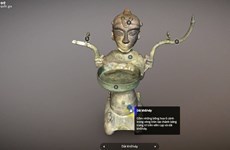The Imperial Seal Ton Than chi bao changed hands after the August Revolution. Hue's Ngu Phung level, on the Ngo Mon tower platform, was the location of this transfer on August 30, 1945.
 |
|
|
Tran Huy Lieu, Nguyen Luong Bang, and Cu Huy Can were among those from the Provisional Revolutionary Government's envoy who received King Bao Dai's abdication sword. It was also decided that the dynasty's property would be turned over.
Treasures, including Imperial Seal Ton than chi bao, were taken to Hanoi after the abdication rites.
The Imperial Seal Ton Than chi bao, according to the National Museum of History, was moved about a lot.
When the national resistance war began in December 1946, the seal was maintained.
After the victory at Dien Bien Phu in 1954, it was restored to the Ministry of Finance's storehouse for administration.
The seal was then given to the History Museum in 1959. Including this seal, the museum delivered a shipment of antiques to the State Bank in 1962 for safekeeping.
“The collection remained fully locked for over 50 years, and only a small number of people were aware of its existence. The National Museum of History sends a representative to the bank's storage facility once a year to verify the integrity of the seal,” the National Museum of History said.
Only in 2007 did the National Museum of History (formerly known as the Vietnam History Museum) earn The Seal, following its extensive renovations and upgrades to a secure storage facility, as well as the installation of new security technology.
The Imperial Seal Ton Than chi Bao was cast in the 8th year of Minh Mang (1827), stated in the national treasure record. Dai Nam Thuc Luc book says: “Cast the Ton Than Chi Bao 3 cun 2 fen broad, 3 fen 6 li long; Sac Menh Chi Bao is 3 cun 2 fen broad, 3 fen 2 li long (all these measurements are approx. 9.5cm according to Ancient Chinese Metric System in use at the time), each handle resembles a meandering dragon, cast in 10-year-old gold. A seal-casting task should be assigned to the Ministries of Ceremonies and Internal Affairs and Weapons.” This was also stated in the book Kham Dai Nam Hoi Dien Su Le.
This two-level square seal of Ton than chi bao was made of 10-year-old gold in the shape of a meandering dragon with its forward-facing head, two long horns, nine flared tails, and five claws. Chinese characters are carved on the back in two separate lines.
The right one translated ‘Cast on the auspicious day of October, the 8th year of Minh Mang, 1827’, and the left one was ‘10-year-old gold weighing 234 liang, 4 qian, 3 fen’ (Ancient Chinese Metric System, approx 8.9kg). ‘Hoang De (Emperor) Ton Than Chi Bao was inscribed on the front’.
Several nicks and dings may be seen on the seal's edge, as well as a small hole in the centre. The seal's weight is listed at 8,983 kg in the application for recognition as a National Treasure.
 |
|
|
The Imperial Seal Ton Than chi bao and the Seal Sac menh chi bao have been identified by the National Museum of History as having a unique layout and decorative form with a big dragon picture, delicately carved into block shape.
The Ton than chi bao seal, on the other hand, is the heaviest gold seal in the collection of royal treasure seals from the Nguyen dynasty and other feudal dynasties in Vietnam.
It is known that the Ton than chi bao seal was formed in a different way, with the picture of a meandering dragon with its head lifted and in majestic stance, as seen in the national treasure records.
Most other seals in the National Museum of History's collection of royal treasures have seal handles depicting dragons in a standing or kneeling position, with their heads straight or twisted and long horns, arched back and curled tail with seven or nine flare-shaped rays.
Ton Than Chi Bao is acknowledged by the National Heritage Council as a symbol of the Nguyen dynasty, a significant historical source documenting the prosperity of Emperor Minh Mang in particular and the development of Vietnamese culture in general during his reign.
Seals ordered by King Minh Mang to be added to the emperor and dynasty's seal system included this one.
Historical records suggest that Imperial seal Ton than chi bao was used to commemorate the emperors and queens of the country by naming them and bestowing on them honorary insignia.
Among feudal dynasties, the Nguyen Dynasty in particular, respecting names was of the essence.
It was Ton than chi bao's dragon picture which was featured in consecration papers and connected with significant royal rites, that became the Nguyen dynasty emblem of authority. It's important to remember that the Nguyen dynasty and Vietnamese history as a whole flourished under Emperor Minh Mang in particular, according to the dossier.
Tu Linh

Vietnam has 23 more national treasures
Deputy Prime Minister Vu Duc Dam has signed decisions to recognise 23 more national treasures.

Vietnam National Museum of History launches 3D tour
The Vietnam National Museum of History has rolled out a brand-new 3D virtual tour, enabling the public to contemplate national treasures.